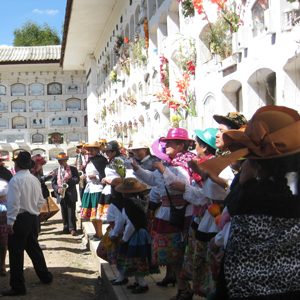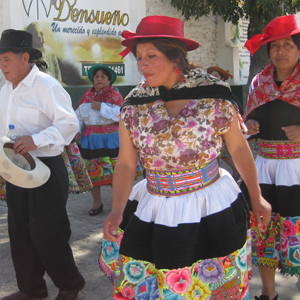There has always been a certain magic about the Andes – it’s a world where the Incans achieved the impossible with their architecture, where tourists are moved speechless by the energy of Machu Picchu, where tradition, dreams, and rituals are revered, where sacred shamans and commoners alike communicate with spirits, and where people from all over the world come to be transformed by ancient healing drugs.



Grandma Rosa loved celebrating Santiago, a Peruvian Andean tradition in honor of the Saint Santiago. When she passed away, she left behind six children and joined six other children who had passed away before her. In her honor and memory, the family and extended family reunite once a year to celebrate Santiago in her name with some family members coming in from as far away as Argentina and Italy.

A full band accompanies the reunited family members as they dance from the chapel to Grandma Rosa’s grave, the men flanked on either side by two rows of ladies. They are headed by the great-aunts, the sisters of Grandma Rosa who exude a certain zest even in their eighties. It’s a sight to see them parading through the streets with the women fully clothed in colorful, traditional Santiago wear and the men raising their sombreros.
After filling her resting place with fresh flowers, each person greets Grandma Rosa by touching the glass that covers her tombstone and making the sign of the cross. Some say a little prayer, and then it’s off to the other side of the cemetery where her brother-in-law lays. Although the family only visits these two pavilions, the cemetery is actually filled with aunts, uncles, sons and daughters who have passed away.

How do you commemorate loved ones past?
Yesterday evening, I visited a small town outside of Huancayo called San Pedro de Saño. As a build-up to the town’s 56th anniversary, they hosted an informal competition of traditional Peruvian dances in their main plaza (that they had just finished constructing this year) of exclusively participants local to the area.
One of my favourite traditional dances is called the “Trilla” – the verb “trillar” means “to thresh” in English. In the dance, there is typically a group of men who go to work in the field, they thresh barley with their V-shaped threshing sticks, the women arrive and give them water for their hard work, and they dance together.
The story of yesterday’s “Trilla” was very different from what I was used to seeing. In the background, a friend of mine sings in Quechua to tell the story. The lyrics told a more serious tale, but there was an air of joy and fun in its presentation and within the crowd.
Below are the parts of the story I was able to extract (because some parts are in Spanish; modern Quechua includes Spanish words and phrases). See if you can pick out when they act/dance each part of the threshing song:
Making a baby
Lift up your child
Give him to his father
Give him to his grandmother
Caring for her grandson
Wash diapers
Smelling, smelling
Kill your child
Stepping, stepping
Now cry for your son
Hit his father
Pull your hair
Bury your son
Crying, crying
Copyright © 2025 Samantha Bangayan | Sitemap | Disclosure Policy | Comment & Privacy Policy
All articles and photos in this blog are licensed under the Creative Commons Attribution License CC BY-NC-ND 3.0.